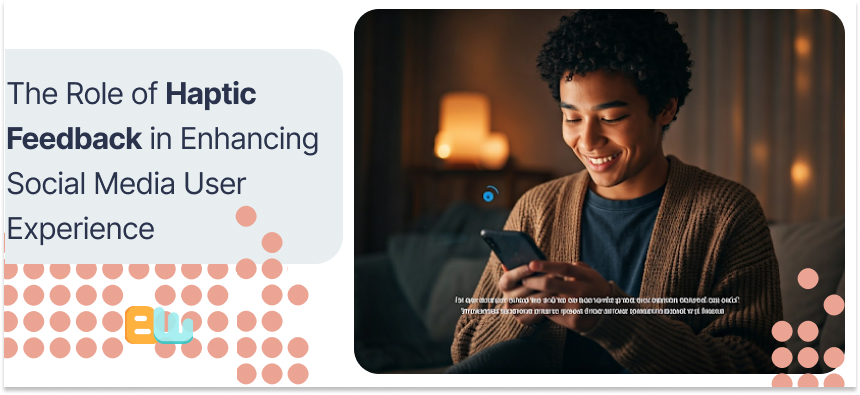
In today’s fast-changing digital world, brands always try to get noticed on social media. To stand out, creating memorable user experiences is very important. Haptic feedback is a technology that uses the sense of touch. This offers marketers a great chance to improve social media interactions. When brands add tactile sensations to digital content, they can build stronger connections and boost engagement. This helps leave a lasting impression on their audience. Imagine scrolling through your social media feed. You could feel a gentle vibration when you watch a video ad. That is the magic of haptic feedback.
Understanding Haptic Feedback in Digital Interactions

Haptic feedback is a technology that helps simulate the sense of touch. It gives users tactile sensations when they interact with digital screens. This technology adds to what we see and hear by making the experience more engaging and immersive. It uses vibrations, forces, or movements to imitate the feeling of real objects and actions in the digital world.
You can already find haptic feedback in your daily life. For example, you feel a gentle buzz when your smartphone gets a notification or a rumble from a gaming controller. In social media, haptic feedback shows up as subtle vibrations when you like a post, share content, or use interactive ads. These tactile signals quickly confirm your actions, improve your sense of connection, and make the experience more enjoyable.
The Basics of Haptic Feedback Technology
Haptic technology uses small motors or parts called actuators to create vibrations, forces, or movements. These actuators are found in smartphones, gaming controllers, and wearables. When the software triggers them, these actuators create tactile sensations. Users feel these sensations through the device’s surface.
The type and strength of these sensations change based on how they are used. A gentle vibration may inform you about a new notification, while a strong vibration could warn you about an error or give feedback while playing a game. Haptic technology aims to connect the physical and digital worlds, making the experience more authentic and engaging.
Evolution of Haptic Feedback in Consumer Electronics
With better consumer electronics, haptic feedback has changed a lot. Mobile devices show this change the most. In the past, users only had vibration alerts for calls and messages. Now, haptic feedback on smartphones gives more detailed responses for different actions. Today, people feel haptic feedback when they type on touchscreens, press buttons, and even when playing certain mobile games and apps.
Wearable technology is another area where haptic feedback is becoming popular. Smartwatches and fitness trackers use it to send notifications, give feedback during workouts, and guide users through navigation. As these gadgets improve and fit more into our daily routines, the role of haptic feedback will grow stronger.
The Role of Haptic Feedback in Enhancing Social Media User Experience

Social media platforms rely heavily on user engagement. When people interact with content, share posts, and join discussions, these platforms become more lively and exciting. Haptic feedback can change this by adding a physical feeling to digital experiences that usually don’t have one.
Think about seeing a video ad on social media. You feel a vibration or pulse from your device as the music gets louder. This slight touch can enhance the emotional effect of the content and make watching it more interesting and unforgettable.
Examples of Haptic Feedback in Popular Social Media Apps
Haptic feedback is still new, but it’s slowly becoming part of popular social media apps. Here are a few examples:
- Interactive Polls and Quizzes: Social media sites might add haptic feedback to polls and quizzes. This will give users a physical confirmation of their choices and make the experience more interesting.
- Livestreaming and Video Content: Haptic feedback can be used in live streams and videos to improve user engagement. Imagine watching a live concert where viewers feel vibrations matching the music. This can make people feel more involved with the show.
- Virtual Reality (VR) Experiences: As social media moves into virtual reality, haptic feedback will help make these experiences more authentic and engaging. Imagine a virtual meet-and-greet with your favorite celebrity where you can “feel” their handshake or get a gentle tap on your shoulder.
Benefits of Incorporating Haptic Feedback into Social Media Interfaces
The use of haptic feedback in social media platforms can bring many benefits. It helps give users a richer experience, which makes them more engaged and builds a stronger emotional connection with the content.
One main benefit is that it makes things more immersive for users. By adding touch sensations that match what happens on the screen, haptic feedback makes interactions more engaging and memorable. This works well for fun content like games, quizzes, and polls, where touch feedback can make users feel more involved.
Integrating Haptic Feedback in Social Media Marketing Strategies

The use of haptic feedback in gadgets is growing. We are starting to see how it can be used in social media marketing. Using this technology in marketing plans could change how brands connect with their audiences.
For example, instead of just scrolling through ads, users could “feel” the fabric of a new clothing brand in a sponsored post. They might also feel the roar of a car engine in a car advertisement. These interactive experiences boost brand recall and make a more substantial, lasting impression on potential customers.
Designing Memorable Haptic Experiences for Brand Campaigns
Creating a good haptic marketing campaign on social media takes careful thought. You want the feel of the ads to match the images and sounds. Here are some tips for brands to create better multisensory experiences:
- Align Vibrations with Brand Messaging: Each vibration should match the central message of the ad campaign. A luxury watch brand may choose soft and classy vibrations. A beverage company, on the other hand, could choose fun and lively vibrations that show its fun brand personality.
- Enhance Storytelling in Video Ads: Haptic feedback can strengthen key moments in video ads. It can highlight parts like product reveals or emotional scenes, which helps hold users’ attention. For example, think about watching a video ad for a new smartphone. While you see the sleek design, you can also “feel” the smooth surface with a gentle vibration on your screen.
- Boost Engagement with Interactive Ads: Haptic feedback makes interactive ads more exciting. Users might “feel” the differences between materials in a virtual showroom or enjoy the thrill of a game with vibrations that match the intensity of action scenes. This type of experience helps create a lasting brand memory and can increase the chances of conversions.
Challenges and Considerations When Implementing Haptic Feedback

Using haptic feedback in social media marketing has great potential but challenges. These challenges include technical problems and making sure devices can work well together. It is also important to use haptic feedback in a way that feels good and does not bother users.
Finding a way to create an interesting and engaging experience is very important. We need to ensure that users do not feel overwhelmed or annoyed. Understanding the limits of technology and keeping user comfort and preferences in mind are vital. This will help us responsibly use haptic feedback.
Technical Limitations and Compatibility Issues
One main problem for marketers who want to use haptic feedback in their campaigns is the difference in haptic technology from one device to another. Not all devices have the same haptic features. For example, many new smartphones have haptic feedback, but how well they work can vary significantly based on the phone’s brand and model.
This difference makes it hard for marketers to maintain a steady user experience on all devices. A mobile ad meant to provide a particular haptic experience may feel very different or even not affect a device that doesn’t support good haptic feedback. This uneven experience may affect how well the ad campaign works and reduce the user’s enjoyment.
Balancing Intrusiveness and User Comfort
Haptic feedback can improve the user experience, but there is a thin line between fun and annoying. If haptic effects are used too much or incorrectly, they can lead to a bad experience. The important thing is to find the right balance. Haptic feedback should be used in a way that improves the understanding without being a distraction.
It is very important to give users control over their haptic experiences. Users should be able to change the vibrations’ strength, set different haptic patterns for various notifications, or turn the feature off entirely. This allows users to make their experiences personal and avoid discomfort. Social media platforms and marketers must prioritize user comfort and avoid forcing this new technology on users.
Future Trends in Haptic Technology and Social Media Marketing

The world of haptic technology is full of exciting possibilities. As technology gets better, we can expect newer haptic feedback systems. These systems will be able to copy many types of tactile sensations. These improvements will create new opportunities for social media marketing and change how we think about digital engagement.
Picture a future where haptic ads do more than just vibrate. You could feel the texture of clothes in a clothing brand’s ad. You might even experience the weight and shape of a new smartphone design. The potential is huge and thrilling.
Innovations on the Horizon for Haptic Feedback
Many exciting new ideas in haptic feedback are set to change advertising in the future. As technology improves, we can expect more advanced haptic experiences. These will mix the physical and digital worlds in new ways.
One interesting area is the creation of high-fidelity haptic actuators. These devices can provide a broader range of tactile sensations, slight pressure, texture, and temperature changes. This lets marketers design a more immersive experiences. For example, users may soon “feel” the chill of a drink can in a social media ad. They could also experience the softness of a cashmere sweater shown by a clothing brand.
Predicting the Next Big Thing in Social Media Engagement Through Haptics
The future of social media marketing will focus on creating unique and engaging experiences for users. Haptic feedback will play an essential role in this change. As our online and real worlds connect more, marketers want new ways to grab attention and build stronger emotional ties with their audience.
Future haptic ads will likely offer more than just simple vibrations. For example, think about joining a virtual product launch event. You could see, hear, and even “feel” the crowd’s excitement through your device. Or imagine scrolling your social media and finding an ad for travel that lets you “feel” the mist from a waterfall or the sun’s warmth on your skin.
Conclusion
Haptic feedback is changing how people use social media. It makes the experience better and keeps users engaged. Using haptic technology in social media marketing, brands can create unique and immersive experiences for their audience. Even with some technical issues, the future of haptic feedback in social media marketing looks bright. New ideas are coming that will make user engagement even stronger. As businesses look at the benefits of haptic feedback, it’s important to balance how much they push with how comfortable users feel. This way, they can create strong and successful campaigns. Stay tuned for the following significant trends in social media engagement through haptic technology.
